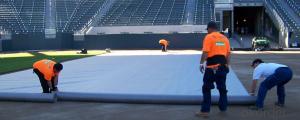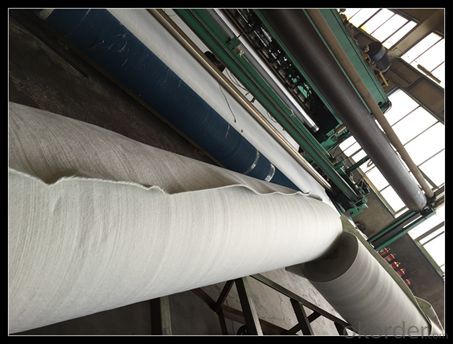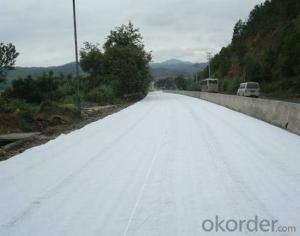Tan Geotextile Nonwoven Geotextile Fabric Polypropylene Roll for Road Construction
- Loading Port:
- China main port
- Payment Terms:
- TT OR LC
- Min Order Qty:
- 1000 m²
- Supply Capability:
- 1000000 m²/month
OKorder Service Pledge
OKorder Financial Service
You Might Also Like
Specification
Geotextile Type:
Non-Woven Geotextiles Woven Geotextiles
Width:
1m-8m
Length:
Customer Requirment
Weight:
100g/m2-1500g/m2
Color:
White, Black, etc
Geotextile is the best solution for the whole construction sites , as there are different types of soils which need to be resolved
the solution was restirected to replacing the unsuitable soils or by expensive deep foundations
The characteristics for the geosynthetic fabrics
high tensile strength
low elongation
a smooth face surface
proper drainage requirements for the installation, meaning high flow or low flow, permeable or impermeable.
Detailed Images

Packaging & Shipping
Packing: PLASTIC FILM INSIDE, AND WOVEN BAG OUTSIDE
Shipping: About 15 days after receipt the deposit
geotextile fabric
permeability,filtration,easy for construction
ISO and CE certificate
Good quality and competitive price
Our Service
Quality assurance
1.On a regular basis or as per your request,we entrust national testing agencies to conduct quality inspections
2. Strictly in accordance with the ISO9001-2008 international quality system standard,we monitor and manage the whole process throughout production,quality testing,and measurement to ensure product quality
3. For quality-related construction delay or substandard construction(except for damage or losses due to customer’s responsibility or irresistible natural disasters),we have refunding,replacement,and repair services.We will respond to customers’ feedbacks on quality issues within 24 hours.
After-sales service
1.In order to provide customers with comprehensive technical support,we will provide technical and other related information upon request in a timely manner.
2.In required,we will appoint specialized technicians to the construction site to give technical trainings to construction people,and offer technical guidance throughout the whole construction process.
3.For damage due to shipment and delivery,after we receive the complaint,we will check the issure through provided pictures and videos.If our responsibility is confirmed,we wil offer free replacement.
4.When the construction is completed,as your request,our technical staff may participate in the final acceptance.
FAQ:
Q: What kind of payments does jenor support?
A: T/T, L/C, Cash are accepted.
Q: Do you charge for the samples?
A: Accordeing to our company policy, the samples are free, we only charge the freight fee. And we will return the freight fee during the next order.
Q: Can you produce according to customers' design?
A: Sure, we are professional manufacturer, OEM and ODM are both welcome.
Q: Do you have other products?
A: Yes, please check the pictures:
- Q: Can geotextiles be used for reinforcement of embankments?
- Yes, geotextiles can be used for reinforcement of embankments. Geotextiles are commonly used in civil engineering projects to improve the stability and strength of embankments. They provide reinforcement by distributing and dissipating forces, preventing soil erosion, and enhancing the overall performance and longevity of the embankment structure.
- Q: Geotextile how to construction?
- Geotextile construction is relatively simple with artificial roll: cloth to be flat, and appropriate to leave the deformation margin. The installation of filament or short wire geotextiles is usually carried out by means of lap, suture and welding. The width of the stitching and welding is generally 0.1 m or more, and the lap width is generally 0.2 m or more. May be exposed to long-term geotextile. It should be welded or stitched. All suture centers need to be carried out continuously (for example, spot joints are not allowed). Before the overlap, the geotextile must overlap at least 150mm. The minimum stitch is at least 25 mm from the weaving edge (the edge of the material exposed). Stitching the seam of the soil includes the first line and the line of the chain. The line used for suturing should be a resin material with a minimum tension of more than 60N. And with geotextile quite or beyond the anti-chemical corrosion and anti-ultraviolet ability. Any "missing needle" on the sewn geotextile must be re-sewn in the affected area. It is necessary to take appropriate measures to prevent the soil, particulate matter or foreign matter from entering the geotextile after installation.
- Q: How to overcome the problems of impervious geotextile?
- Geotextile is a filter and protection function, itself is permeable. The main material of impermeable material is geomembrane.
- Q: Can geotextiles be used in geocomposite applications?
- Yes, geotextiles can be used in geocomposite applications. Geocomposites are materials made by combining different geosynthetic components, including geotextiles, to achieve specific engineering functions. Geotextiles, due to their high tensile strength, filtration capabilities, and drainage properties, are commonly used in geocomposites to enhance the overall performance and functionality of the composite material.
- Q: How do geotextiles affect soil moisture retention?
- Geotextiles can significantly impact soil moisture retention by acting as a barrier between the soil and the external environment. They help in reducing excessive evaporation from the soil surface, thus minimizing water loss. Additionally, geotextiles prevent the erosion of soil particles, maintaining soil structure and facilitating better water infiltration. This ultimately improves soil moisture retention by creating a more favorable and stable environment for plants to grow.
- Q: Can geotextiles be used in pond liner applications?
- Yes, geotextiles can be used in pond liner applications. Geotextiles are commonly used as a protective barrier or reinforcement in pond liners to prevent soil erosion and provide additional stability.
- Q: Geotextile belongs to what industry
- Geotextile belongs to the building materials industry
- Q: Are geotextiles suitable for use in bridge construction?
- Yes, geotextiles are suitable for use in bridge construction. Geotextiles offer various benefits such as soil stabilization, erosion control, and drainage improvement, which are crucial for the long-term durability and performance of bridges. Additionally, geotextiles can help distribute loads and reduce stresses on the bridge structure, enhancing its overall stability.
- Q: Can geotextiles be used in coastal erosion control structures?
- Yes, geotextiles can be used in coastal erosion control structures. Geotextiles are often used as a component of erosion control systems to stabilize the soil and prevent erosion. They can be placed in coastal areas to reinforce structures such as revetments, groynes, or breakwaters, helping to reduce wave impact and erosion.
- Q: Thank you, great gods
- Polyester short wire, polyester filament, polypropylene geotextile, filament woven geotextile, and so on. I professional production geotextile geomembrane and other geotechnical materials, a professional construction of the welding team, wish smooth
Send your message to us
Tan Geotextile Nonwoven Geotextile Fabric Polypropylene Roll for Road Construction
- Loading Port:
- China main port
- Payment Terms:
- TT OR LC
- Min Order Qty:
- 1000 m²
- Supply Capability:
- 1000000 m²/month
OKorder Service Pledge
OKorder Financial Service
Similar products
Hot products
Hot Searches
Related keywords
































